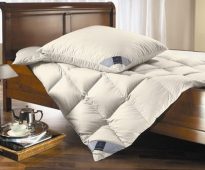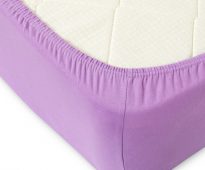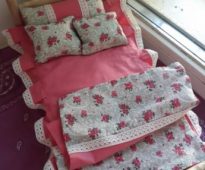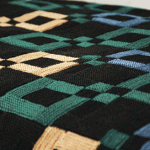Knitting in patchwork style
The cover of patchwork yarn is a canvas, like a mosaic made up of multi-colored knitted patches. Such products usually turn out beautiful and unusual.
The product is made up of many separately related fragments, which may differ in color, pattern, size, shape.
There are different knitting techniques, more complex and extremely simple. Here we will get acquainted with the most common options for creating knitted patchwork blankets.
Content
- 1 What yarn to use?
- 2 Knitting Patchwork Tools
- 3 Basic techniques of knitting a plaid in patchwork style
- 4 Knitting patchwork: plaid, connected by simple squares from a corner
- 5 Triangle patchwork patchwork
- 6 Spatula of squares connected in a spiral
- 7 Crocheted blankets: square with corner with crocheted columns
- 8 How to tie the traditional "Grandma square"
- 9 Simple and stylish scheme: the plaid, connected by return rows
- 10 Children's patchwork blanket
- 11 Combined patchwork
- 12 Video: Diamonds Plaid
- 13 50 photo ideas for inspiration and creating beautiful and unusual plaids with knitting and crocheting:
What yarn to use?
To create a cozy multi-colored plaid you will need several skeins of yarn of different shades.
Such work begins with the selection of the source material - yarn. Traditionally for this kind of needlework used thread left over from knitting other things. But you can pick up and buy something specifically for patchwork style bedspreads.
Important! The product must be completely knitted from the same yarn thickness. The pattern, the dimensions of the constituent pieces, the color, the composition of the threads may vary. But not knit density.
Knitting Patchwork Tools
The preparation of the tools is another important part prior to the base work. You will need the following.
- Hook
Even if you plan to use knitting needles, this tool can be useful to pre-dial a number of air loops. Its appearance depends on the parameters of the yarn.
- Spokes
For different techniques, 2 to 5 double-edged spokes can be used simultaneously. A larger quantity for such products is rarely needed.
- Pins
English or regular tailor pins may be useful.
- Scissors
To trim the thread if necessary.
- Needle
It will be required for some knitting methods, when separate fragments are first created. And only then they are combined into a single canvas.
Making sure that there is everything you need, you can get to work.
Basic techniques of knitting a plaid in patchwork style
Patchwork is a combination of a simple geometric shape combined together. Most often this happens:
- squares;
Square crochet patchwork
- triangles;
Simple crocheted triangles are a great motif for collecting interesting items.
- hexagons;
Common motifs are hexagons for simple and complex products.
- diamonds.
Plaid cover of rhombus with crochet looks original and volume
Such constituent pieces are called motifs. They are created by knitting or crocheting, using different patterns, from the corner or from the center. There are many options. The table shows the most basic technology.
| knitting needles | hook | |
|
|
from the corner |
|
|
from the center |
According to the method of connecting the pieces together, all the techniques are divided into the following.
- Match as a whole
Completing one motive, in this situation, they immediately go to the next, tying them in a row. In order for a blanket made in such a way to be successful, it is better to draw a sketch-scheme before knitting and begin to knit in accordance with it.
A surprisingly simple plaid of squares knits with one cloth: one motif is tied onto another according to the instructions.
- Like a mosaic
That is, you first need to make individual elements, and only then put them together and link them together.
Plaid on a double bed of bright various elements
Both methods have advantages and disadvantages. Knitting by the first method does not require additional sewing with a needle, but does not allow making significant adjustments to the pattern during the work. The second is more laborious, but allows you to experiment right in the process of creating a rug.
Knitting patchwork: plaid, connected by simple squares from a corner
Bright plaid of squares knitting needles knitted from the corner
The most common method of creating a curtain in the style of the patchwork knitting needles is the so-called kerchief knitting. It is a combination of facial loops and reductions. The process is as follows.
- Dial an odd number of loops for the base
Their exact number depends on the size of the square. And equal to the sum of the loops horizontally and vertically, plus one corner loop.
- Knit a motif with face loops
Performing in the process on each second row decrease of three loops in the middle.
- Form the outer edge of the motif with knots
That is, always removing the first loop of the series, not knitting it.
- Complete the square
When, as a result, there is only one loop in the row that is constantly diminishing, cut and secure the thread.
- Start the next motive
The basis for it will be one of the sides of an already connected fragment and a series of type-setting loops.
Thus, step by step, a whole web of yarn is created. It is important not to change the knitting direction in the process, so that the protruding convex diagonals on the front side of the rug, which are obtained in the process, are directed in one direction.
Triangle patchwork patchwork
From the available threads we knit triangles of the same size in different colors
Textiles made up of triangles, looks spectacular, and it is easy to knit. For this:
- Dial a chain of six air loops;
- Close it into a ring by a semi-column without a nakida;
- Insert the double-edged needle into every two loops so as to form the base for the sides of the future triangle;
- Next double the number of loops;
- Knit a simple facial pattern, adding two loops to each side of the triangle in each row until the fragment reaches the desired size.
Hook two adjacent triangles together using only one back wall from the loop of each part.
This simple, unusual and attractive motif is capable of becoming the basis for an excellent knitted plaid.
Ready blanket of knitted triangles in the interior
Spatula of squares connected in a spiral
This type of knitting needles is very similar to the previous technique of execution. The creation of this motif also begins with knitting a chain of air loops - however, in this case there should be eight of them. Then the loops in exactly the same way are closed into a ring and distributed along the spokes, forming the edges of a square.
After this, the element is knitted with a facial pattern; each next row must be started with a nakida, thereby increasing the number of loops. The knitting should be continued until the fragment reaches the desired size.
Thus obtained element has on its front surface convex arc-helix, diverging from the center in four directions. Visually, it looks quite interesting.
Crocheted blankets: square with corner with crocheted columns
Crochet scheme with a corner
This alternative to the simplest patchwork with knitting needles in the form of squares looks similar, but knits it in a slightly different way. The main difference is that you first need not to dial a chain of loops, but to make one single loop.
Knitted module for crocheted rug
From it, first tie three columns with a double crochet, then two air loops, then two more columns. Perform the second row in the same way as the first, but include two more columns in it. Continue to knit until the figure reaches the planned size.
Bright crochet plaid from square motifs, tied off from a corner
This method of patchwork knit is obtained relatively free, even openwork. However, it depends on the thickness of the yarn. Thicker threads give a denser web.
How to tie the traditional "Grandma square"
This type of drawing combines simplicity and aesthetic appeal. For this reason, this knitting is very common. But with the help of original colors, well-chosen yarn, you can transform it, make it play with new colors.
To connect crocheted parts, you can use the scheme
It fits in from the center, according to the following scheme:
- make three double crochets from the starting loop;
- tie two air loops;
- this is followed by three more similar columns from the initial loop, two air loops;
- repeat this algorithm two more times;
- close the circle with a single crochet;
We knit loops in a circle according to the pattern 4 times - 3 double crochets, 2 air loops, we connect
- second row tie the same groups of columns with a double crochet of three pieces from the air loops of the previous row;
Create a 2 row, marking the angles of the motive
- in the classical version of this pattern there are only four rows, but it is acceptable to increase this number to five, six, seven and so on.
We make different in size blanks of two, four, six, eight and ten rows
Schemes of knitted squares for beautiful and original bedspreads
By shifting the middle of the "grandmother's square" to the edge, you can give this traditional pattern asymmetry and originality.
The scheme of the pattern “Grandma square” for knitting with a corner
The square motif of the “grandmother's square” associated with the angle
After the parts are ready to neatly sew the parts together
Combining different colors, we get an incredibly beautiful bedspread
Simple and stylish scheme: the plaid, connected by return rows
Unusual plaid, knitted in reverse rows
This technique begins with the usual "grandmother's square" from the center. However, after the standard three or four rows in a circle there are differences. Taking the bottom and left sides of the workpiece as a basis, form one row of columns without quilting, two with double crochet and one more, final, without crochet. Then repeat the same sequence of actions, starting from the top and right sides of the figure.
You can act according to this scheme, periodically changing colors, as long as the final dimensions of the product will not suit you.
Children's patchwork blanket
The secret to creating a successful children's blanket is the correct selection of the following elements.
- Pattern
For such a product is well suited dense types of knitting. Plaids with a convex pattern on the front side look good.
- Colors
Children's things are usually made variegated and bright. However, do not forget that the shades of the rug should be in harmony with each other. Patchwork - multicolor style, but not tasteless.
- Yarn
When knitting things for small children it is better to refrain from materials that can cause allergies. This means that natural wool should prefer yarn based on cotton or synthetic.
Another difference is the size of such blankets. Bed covers for children are usually made less than for adults.
Combined patchwork
Warm cozy knitted blanket from elements of different color, size and shape
The specificity of patchwork allows you to combine not only yarn of different colors, but also different types of patterns. Knitted flowers can alternate with smooth hexagons consisting of double crochets. Sophisticated openwork motifs work well along with simple schemes contrasting with them.
To create such a complex, unusual thing that combines disparate elements, start knitting by drawing a detailed sketch. And it should be detailed, elaborated. And deviate from the original plan is not worth it.
Do not be afraid to experiment! Try, fantasize, and, ultimately, be able to create a truly unique and beautiful patchwork-style blanket.
Video: Diamonds Plaid
50 photo ideas for inspiration and creating beautiful and unusual plaids with knitting and crocheting:
 Quilt size
Quilt size
 How to fix the sheet on the mattress so that it does not slip
How to fix the sheet on the mattress so that it does not slip
 Bedding for dolls
Bedding for dolls







